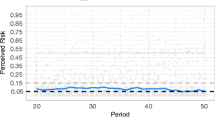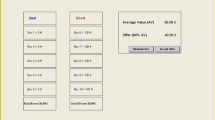Abstract
This article reports an experiment which tests the principle of separability, i.e. that behaviour in a dynamic choice problem is independent of history and of unreachable eventualities. Although this is a well-known principle of orthodox decision theory and central to conventional economic modelling, it has been questioned on grounds suggested by non-expected utility models of choice under risk and by the psychology of affective influences on risk-taking. Our experimental design, which provides between-subjects tests of separability using three treatments in which the history preceding a decision is manipulated, is inspired by these concerns. We expose separability to a clean and harsh test, but find no evidence that it is violated.
Similar content being viewed by others
References
Bardsley N., Cubitt R., Loomes G., Moffatt P., Starmer C., Sugden R. (2010) Experimental economics: Rethinking the rules. Princeton University, Princeton
Beattie J., Loomes G. C. (1997) The impact of incentives upon risky choice experiments. Journal of Risk and Uncertainty 14: 149–162
Bermudez J. L. (2010) Pitfalls for realistic decision theory: An illustration from sequential choice. Synthese 176: 23–40
Bratman M. E. (1987) Intention, plans, and practical reason. Harvard University, Cambridge (Mass.)
Busemeyer J. R., Weg E., Barkan R., Li X., Ma Z. (2000) Dynamic and consequential consistency of choices between paths of decision trees. Journal of Experimental Psychology: General 129(4): 530–545
Camerer C. F. (1995) Individual decision making. In: Kagel J., Roth A. E. (eds) Handbook of experimental economics. Princeton University, Princeton
Cohen M., Etner J., Jeleva M. (2008) Dynamic decision making when risk perception depends on past experience. Theory and Decision 64: 173–192
Cubitt R. P., Starmer C., Sugden R. (1998a) Dynamic choice and the common ratio effect: An experimental investigation. Economic Journal 108: 1362–1380
Cubitt R. P., Starmer C., Sugden R. (1998b) On the validity of the random lottery incentive system. Experimental Economics 1: 115–131
Cubitt R. P., Starmer C., Sugden R. (2001) Discovered preferences and the experimental evidence of violations of expected utility theory. Journal of Economic Methodology 8: 385–414
Cubitt R. P., Starmer C., Sugden R. (2004) Dynamic decisions under uncertainty: Some recent evidence from economics and psychology. In I. Brocas & J.D. Carrillo (Eds.), The Psychology of economic decisions: Reasons and choices (Vol. 2). New York: Oxford University.
Cubitt R. P., Sugden R. (2001) Dynamic decision-making under uncertainty: An experimental investigation of choices between accumulator gambles. Journal of Risk and Uncertainty 22: 103–128
Isen A. M. (1999) Positive affect. In: Dalgleish T., Power M. (eds) Handbook of cognition and emotion. Wiley and Sons, New York
Isen A. M., Nygren T. E., Ashby F. G. (1988) The influence of positive affect on the perceived utility of gains and losses. Journal of Personality and Social Psychology 55: 710–717
Johnson J. G., Busemeyer J. R. (2001) Multiple-stage decision-making: The effect of planning horizon length on dynamic consistency. Theory and Decision 51: 217–246
Johnson E., Tversky A. (1983) Affect generalization, and the perception of risk. Journal of Personality and Social Psychology 45: 20–31
Loewenstein G., Adler D. (1995) A bias in the prediction of tastes. Economic Journal 105: 929–937
Loewenstein G., O’Donoghue T., Rabin M. (2003) Projection bias in predicting future utility. Quarterly Journal of Economics 118: 1209–1248
Loomes G. (2005) Modeling the stochastic component of behaviour in experiments: Some issues for the interpretation of data. Experimental Economics 8: 301–323
Loomes G., Sugden R. (1995) Incorporating a stochastic element into decision theories. European Economic Review 39: 641–648
Loomes G., Sugden R. (1998) Testing different specifications of risky choice. Economica 65: 581–598
Machina M. (1987) Choice under uncertainty: Problems solved and unsolved. Journal of Economic Perspectives 1: 121–154
Machina M. (1989) Dynamic consistency and non-expected utility models of choice under uncertainty. Journal of Economic Literature 27: 1622–1668
McClennen E. F. (1990) Rationality and dynamic choice: Foundational explorations. Cambridge University, Cambridge
Nygren T. E., Isen A. M., Taylor P. J., Dulin J. (1996) The influence of positive affect on the decision rule in risk situations: Focus on outcome (and especially avoidance of loss) rather than probability. Organizational Behaviour and Human Decision Processes 66: 59–72
Post T., Van den Assem M. J., Baltussen G., Thaler R. H. (2008) Deal or no deal? Decision making under risk in a large-payoff game show. American Economic Review 98: 38–71
Slovic P. M., Peters E., Finucane M. L., MacGregor D. G. (2002) The affect heuristic. In: Gilovich T., Griffin D., Kahneman D. (eds) Intuitive judgement: Heuristics and biases. Cambridge University, New York
Starmer C. (2000) Developments in non-expected utility theory: The hunt for a descriptive theory of choice under risk. Journal of Economic Literature XXXVIII: 332–382
Wakker P. P. (1999) Justifying Bayesianism by dynamic decision principles. Leiden University Medical Center, mimeo
Wilcox N. (2008) Stochastic models for binary discrete choice under risk: A critical primer and econometric comparison. In: Cox J. C., Harrison G. W. (eds) Research in experimental economics (Vol. 12): Risk aversion in experiments. Emerald, Bingley, UK, pp 197–292
Author information
Authors and Affiliations
Corresponding author
Rights and permissions
About this article
Cite this article
Cubitt, R., Ruiz-Martos, M. & Starmer, C. Are bygones bygones?. Theory Decis 73, 185–202 (2012). https://doi.org/10.1007/s11238-010-9233-4
Published:
Issue Date:
DOI: https://doi.org/10.1007/s11238-010-9233-4




